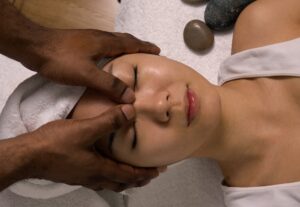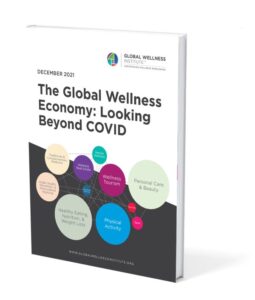By Liza Horan, Editor
Covid-19 contributed to the deaths of nearly 15 million people, the World Health Organization announced today. While much of modern life has seemed to have moved on from the pandemic’s restrictions on testing, wearing masks and travel, that figure shows the scale of impact from a health matter that has guided our lives globally and individually for two years.
It was a learning experience. We know more now about how to boost our immunity, the importance of social interactions and the healing power of nature. Most importantly, perhaps, we learned that responsibility for our health and mental wellbeing starts with us.
We went online to cope, and that was both a relief (connection!) and a burden (Zoom fatigue!). It also was a mixed blessing for the wellness industry.
Wellness industry took a (temporary) hit during Covid
The Covid effect on the global wellness industry is estimated at a loss of $500 million in 2020 due to shut-downs of gyms, spas and wellness travel, among others. But a rebound is under way.
“With the massive economic shocks from COVID-19, the global wellness economy fell 11% to $4.4 trillion in 2020,” according to the Global Wellness Institute’s report, The Global Wellness Economy: Looking Beyond Covid. “But with the pandemic ushering in a major shift in values for consumers, governments, and the medical world — where prevention and wellness take on far greater importance — the GWI predicts that the wellness market will return to pre-pandemic levels in 2021 ($5 trillion), and will grow at an impressive 10% annual pace through 2025, when it will reach $7 trillion.”
The 100-page report, which is free to download, surveyed new economic data across 11 sectors. A particular highlight was the geographic growth report for use of Traditional & Complementary Medicine, which encompasses “many different holistic, traditional, indigenous, and mentally- or spiritually-based practices, including homeopathy, naturopathy, osteopathy, chiropractic, acupuncture, Traditional Chinese Medicine, Ayurveda, Unani medicine, energy healing, traditional/herbal remedies and supplements, and much more. Many T&CM practices are native to the country or region where they are used, although a number of practices (e.g., acupuncture, Traditional Chinese Medicine, chiropractic) are now commonly practiced around the world.”

Touch therapies, like massage and reflexology, that offer holistic benefits are growing in demand. PHOTO Pexels/William Adams
The data shows these holistic practices grew 7.1% worldwide from 2017 to 2019. In 2019-2020, growth was seen only in the North America and Middle East-North Africa regions, though it’s important to note that there’s widespread use of these practices already in Asia and Europe. The highest per capita spending in 2020 on these practices was in North America — and it was double the next highest spend (Europe). In North America, per capita spending on Traditional & Complementary practices was $119.21.
This demonstrates that the mind-body-spirit movement is growing on a grassroots level — but that’s not all…
GREATER ACCEPTANCE OF TRADITIONAL HEALING
Many traditional healing practices have been around for millennia — such as plant medicine, energy medicine, and nutritional therapies — are now being recognised by the conventional medical institution.

Ancient practices for health and wellbeing used by indigenous people have much to offer conventional Western medicine, the WHO says. PHOTO Pexels/Karolina Balogova
WHO commits to protecting and learning from ancient ways
The World Health Organization has established the Global Center for Traditional Medicine in India to ensure that ancient practices of indigenous people get protected and integrated into conventional Western medicine. The Center “aims to harness the potential of traditional medicine from across the world through modern science and technology to improve the health of people and the planet.”
This is significant because while 80% of the world’s population is estimated to use traditional medicine the focus of medical research has not been on these natural and often holistic practices, such as herbal medicines, acupuncture, yoga, indigenous therapies and others. In fact, most pharmaceutical drugs are based on plant medicine. Establishing this Center is a call for research, open-minded and respect for traditional ways, which is bound to further integrate holistic practices in conventional medicine.
Europeans want Traditional Medicine prioritised
Tibetan medicine, known as Sowa Rigpa (the ‘science of healing’), is one of those Traditional Medicine practices. It is a holistic modality focused on balancing body, energy and mind, and just one of several complementary and alternative medicine (CAM) modalities that Europeans want to access through national healthcare.
EUROCAM, the commission representing the interests of practitioners and citizens, supports the WHO’s commitment to traditional medicine and urges the European Parliament to mainstream CAM modalities, which range from acupuncture and homeopathy to herbal medicine and yoga. The group says these ought to be the first line of prevention and treatment, rather than conventional medicine and pharmaceutical options because these CAM offers many benefits — including being more affordable, less invasive and longer-lasting than conventional medicine.
Psychedelics poised for mainstream use
Psychedelic drugs, like psilocybin (“magic mushrooms”) and MDMA (“ecstasy”), are so effective for depression and PTSD that the U.S. Federal Drug Administration is expected to approve their use in 2023. Industry pundits expect that decision to create a $10 million market around psychedelics.
“Once dismissed as the dangerous dalliances of the counterculture, these drugs are gaining mainstream acceptance. Several states and cities in the United States are in the process of legalizing or decriminalizing psilocybin for therapeutic or recreational purposes,” Paul Tullis wrote in journal Nature. “Psychedelic-assisted psychotherapy could provide needed options for debilitating mental-health disorders including PTSD, major depressive disorder, alcohol-use disorder, anorexia nervosa and more that kill thousands every year in the United States, and cost billions worldwide in lost productivity. But the strategies represent a new frontier for regulators.”
The shift of mindset from “illicit drugs” to “modern medicine” is new territory. As governments, law enforcement and the medical community consider implications and opportunities, so is the wellness industry.
The Psychedelics & Healing Initiative is a new effort by the Global Wellness Institute to aggregate and share ethical standards and psychedelic industry best practices, discuss policy, set a glossary of terms, and more.
“It will be a collaborative of physicians, business innovators, research scientists, impact investors, policy makers and ethnobotanists who hold leadership positions in psychedelic biomedical companies; in organizations that exemplify the highest ideals of psychedelics and healing; or who are actively engaged in advocacy and exploration of how psychedelics can heal, expand consciousness, and nurture community,” the GWI says.

The use of psychedelics have been shown to promote feelings of oneness with all things, as well as alleviate symptoms of depression and PTSD when used within a prescribed therapeutic programme. PHOTO Pexels/Alina Kurson



Comments